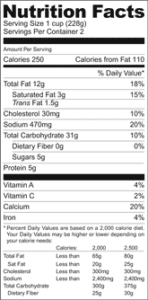
The nutrition facts label on food products tells you what’s in the food you’re eating and how much. It helps you determine if you have a healthy, balanced diet. Every packaged and processed product should have a label. Today, even some fresh products have a label. Some restaurants also have nutrition facts information available. The label includes amounts in the areas below. They are listed per serving, what a serving equals, and as a percentage of the daily value.
Here is an example of what’s listed on the nutrition facts label:

- Calories
- Total fat
- Saturated fat
- Trans fat
- Cholesterol
- Sodium (salt)
- Total carbohydrate
- Dietary fiber
- Sugars
- Protein
- Vitamins and minerals
Path to improved health
Serving size is the first piece of information listed on the label. This is the amount of food that is typically eaten at one time. The size is in a basic household measurement, such as pieces, cups, or ounces. For example, a serving may be 7 potato chips or 1 cup of cereal.
Serving size is an important factor in your diet. You should compare the amount of that food you normally eat to the serving size listed on the label. Eating large servings or portions can lead to weight gain. The larger your portions are, the more calories you eat. For example, the label may list a serving size as 7 potato chips. If you eat 14 chips, you are consuming twice the amount of calories and nutrients.
The label provides a column of percentages called the percent daily value. It compares how much of a nutrient is in one serving of food to how much of that nutrient you should consume in one day. The percentages are based on a daily diet of 2,000 calories. You’ll need to adjust the amounts if you eat more or less than 2,000 calories per day. Everyone has different calorie needs. These depend on your gender, age, and activity level.
You get your daily calories from what you eat and drink. A healthy person should consume nutrients from the five basic food groups (fruits, vegetables, grains, protein, and dairy). Some ingredients, such as saturated and trans fats, are unhealthy. You only should eat these in small amounts. A serving with 5% or less of the daily value is low. A serving with 20% or more of the daily value is high.
Things to consider
Not all nutrients, or ingredients, listed on a label are equal. Some are better for you and should be eaten more. These include:
- Fiber helps your body digest the food you eat. It also can help lower your risk of diabetes, heart disease, and certain types of cancer. Food is high in fiber if it contains 5 grams or more per serving. Men 50 years of age or younger should get at least 38 grams of fiber per day. Women 50 years of age or younger should get at least 25 grams of fiber per day. Fiber is found in fruits, vegetables, and whole grains. Look for the words “whole grain” on the package and ingredient list.
- Vitamins and minerals.The main types include, vitamin A, vitamin C, calcium, and iron. Vitamin D and potassium also are important. Talk to your doctor about what vitamins and minerals you need and how much. In some cases, you may need to lower the amount of vitamins and minerals you consume. For example, if you have high levels of potassium, which can lead to cardiac problems, you may need to eat fewer foods containing potassium. This would include foods such as bananas, potatoes, and tomatoes/tomato sauce.
Other nutrients are bad for you and should be eaten less. These include:
- Saturated fat.This type of fat can increase your risk of heart disease and high cholesterol. The average adult should consume less than 20 grams of saturated fat per day.
- Trans fats.This type of fat also increases your risk of heart disease. Ideally, you should get 0 grams of trans fat per day. Keep in mind, companies can list 0 grams if it contains less than 0.5 grams of trans fat per serving. This means that your food may have trans fats even if the nutrition label says 0. Check the ingredient list for trans fats products. This includes any hydrogenated vegetable oils. Trans fat often is found in baked goods, fried foods, snack foods, and margarine.
- You should eat less than 300 milligrams of cholesterol per day. If you have heart disease, aim for less than 200 milligrams per day.
Questions to ask your doctor
- How do I know how many calories I need?
- Are all products labeled “fat-free” good for me?
- If the nutrition facts label lists 0 grams of cholesterol, is it good for me?
- What if the serving size listed seems low?
Resources
American Academy of Family Physicians, Nutrition: Determine Your Calorie Needs
American Academy of Family Physicians, Vitamins and Minerals: How to Get What You Need
U.S. Food & Drug Administration: How to Understand and Use the Nutrition Facts Label
![]()
Copyright © American Academy of Family Physicians
This information provides a general overview and may not apply to everyone. Talk to your family doctor to find out if this information applies to you and to get more information on this subject.







